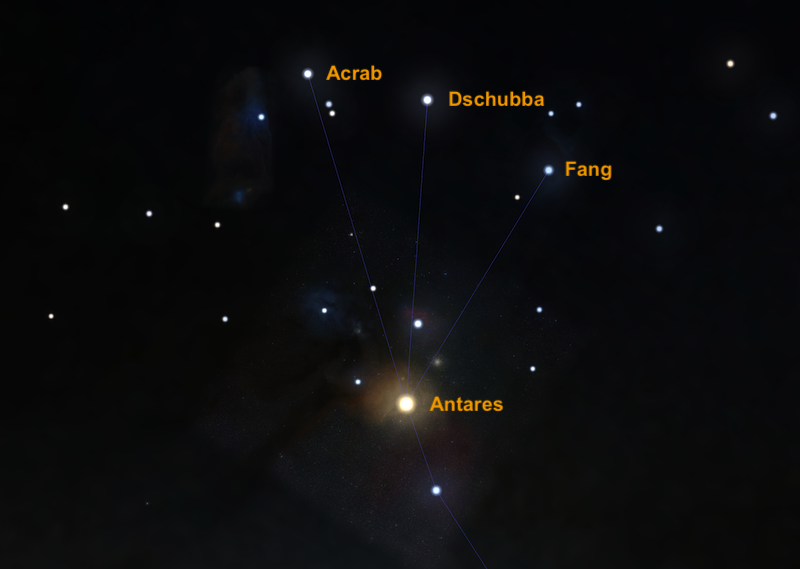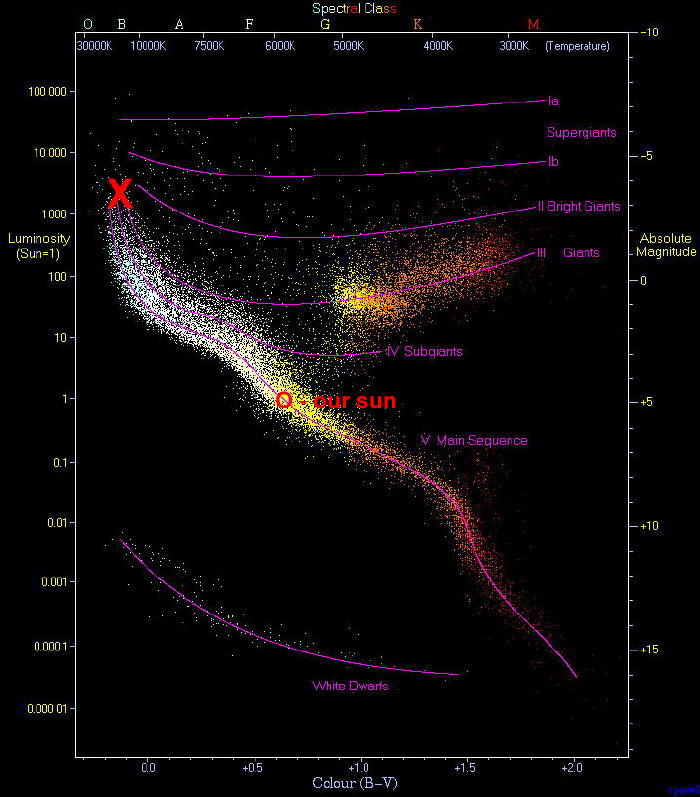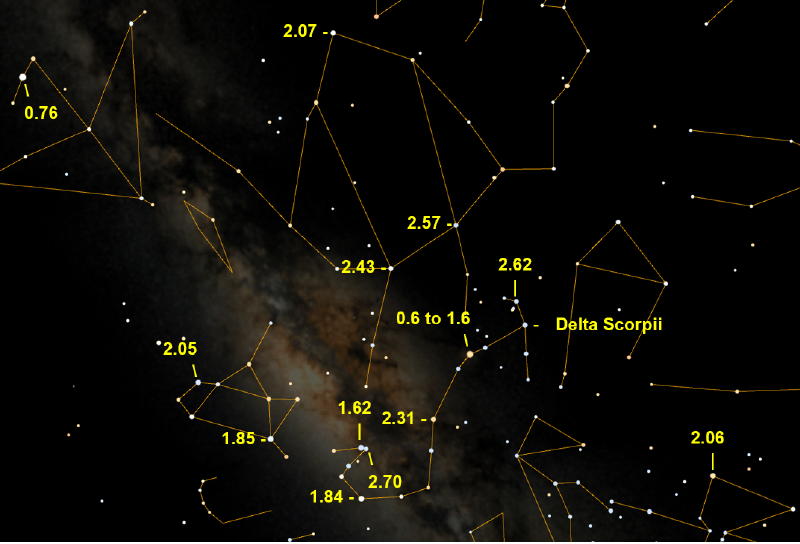
Finding (and pronouncing) Dschubba
Delta Scorpii – aka Dschubba – is easy to spot as the middle star in the “forehead” or Crown of the Scorpion, Scorpius. And it’s an extremely interesting star – well worth watching – unpredictably variable in a way that you can watch with your eyes alone.
On these northern summer evenings, we in the Northern Hemisphere see Scorpius and Delta Scorpii (Dschubba) in our southern sky. For Southern Hemisphere viewers, they are closer to overhead. Scorpius is an easy constellation to find, because of its curved “tail” of stars. And the brightest star in Scorpius, Antares, will catch your eyes.
To the west of Antares, you’ll find a little arc of three stars. They are tiny, but noticeable. Dschubba, the middle star, is usually the brightest of the three.
How do you pronounce Dschubba? The “D” is silent. So now we are left with “schubba”. It is two syllables, emphasizing the first: SCHUB ba. Something like “shoe ba”. Hear some pronunciations of Dschubba here.
You can also simply call the star Delta Scorpii.

Delta Scorpii: Forehead, Claw or Crown?
Delta Scorpii derives its name from the Arabic phrase meaning “the forehead” of the Scorpion. This part of the constellation is also sometimes called “the claws” of the Scorpion.
But most stargazers know that the Scorpion’s true claws once extended well beyond the boundaries of Scorpius and into the constellation of Libra the Scales. At some point, far back in the history of our sky, they clipped Scorpion’s claws to make room for Libra. Thus, we now have 12 constellations of the zodiac.
The little arc of 3 stars above Antares is also called the Crown of the Scorpion.
How big and bright?
Dschubba is a moderately bright star in our sky. But it’s relatively distant at 491 light-years away. The light you see beaming from Dschubba tonight left the star in the year 1533. A lot has happened here on Earth since 1533. What has the starlight been doing? Some of it has been kidnapped. There is so much dust and gas between us and the star that half of the light has been reflected and absorbed in the past 491 years. So, what we see is only half as bright as it would be if we had a clear view.
Dschubba is a type B0 star, meaning it is hot, about 22,000 Kelvin, or four times hotter than our sun. It’s a massive star too, with 13 times more mass than our sun. It’s about 7 times larger than our sun. And it’s about 14,000 brighter than the sun.

2 types of variability
Dschubba has not one but two types of variability. First, it shows irregular, small brightness variations. Those variations happen every few days and are probably due to bright spots or clouds of gas between us and the star.
The second type of variability is eruptive and unpredictable.
Dschubba is a Gamma Cassiopeiae variable star. That means it behaves like the star Gamma Cassiopeiae, the poster child for a star with these eruptive brightness changes.
Gamma Cassiopeiae – the middle star in the “W” of constellation Cassiopeia – is what’s known as an eruptive variable star. Its magnitude, or brightness, has in the past varied between a bright magnitude 1.6 and a fainter magnitude 3.0. And it spins so rapidly that it occasionally flings off material. This material forms a disk of hot gas surrounding the star near its equator.
And thus, Gamma Cass brightens, not quickly, but slowly, over a few weeks to a few months. In 1937, Gamma Cassiopeiae brightened from magnitude 2.2 to 1.6 (the smaller the number, the brighter the star), then dimmed to magnitude 3.4. In the decades since, the star has slowly brightened to magnitude 2.3 again. But it has not repeated its behavior of 1937.
Only a few other such stars are known to exist, one being the star Dschubba.
An eruption disruption for Dschubba
Like Gamma Cass, Dschubba rotates quickly. At the equator, it reaches a rotational speed of 112 miles per second (180 km/s). This is 90 times faster than our sun.
Astronomers believe that, occasionally, the star throws off material that forms a disk around its equator. This would be a big disk, 150 times larger than our sun. It’s this disk that causes changes in the brightness of Delta Scorpii.
At one time, Dschubba was a spectroscopic standard for the B0 IV star classification. But this variability in brightness got it removed from being a standard. You see, even stars misbehave and get kicked out of the class.
It has a companion
Dschubba is also part of a multiple-star system. It has a companion that is 10 times fainter, orbiting it every 20 days. And there is another star in this system, which might also trigger the brightness outbursts.
The second star gets as far away from the main star as our planet Saturn is from our sun. And it takes 10.8 years to orbit the main star. Every 10.8 years, the second star passes very close to Dschubba, and this passage might stir up the atmosphere of the main star, causing the main star to brighten. Or maybe not. Scientists are not sure about this; the star had an outburst that began in 2000 which may have been related to the close passage of the star. However, its passage in 2011 and 2022 didn’t have a significant outburst.
See for yourself
With the unaided eye, and within minutes, you can estimate the brightness of Delta Scorpii.
Simply compare its brightness to other stars nearby. The non-variable stars are marked on the map below. While it might be tempting to use the star Antares in your estimations, avoid it because it also varies in brightness.
Typically, Delta Scorpii is about magnitude 2.3, but it has been known to brighten up to magnitude 1.6. Remember, the higher the number, the fainter the object. So how bright is it tonight?

A few tips
Take your time. Compare the subject star (Delta Scorpii) to each of the labeled stars on the map. Is it brighter or fainter? Keep doing that, comparing the subject star to the other stars on the map. Avoid using stars near your horizon as extinction will make them appear fainter than they are.
When you have arrived at a number, write it down, along with the date and time. Then go out again tomorrow night and do it again. After four or five nights, you will feel comfortable making magnitude estimates. You can even send in your results to the clearinghouse for star magnitude estimates: the American Association of Variable Star Observers (AAVSO). You can submit data for free or pay a fee, join the organization, and receive a cartload of benefits. Plus, you have the satisfaction of contributing to the science of Delta Scorpii.
Bottom Line: Delta Scorpii, also known as Dschubba, is a variable star in the constellation Scorpius. With the eyes alone, you can check its brightness for yourself, and for science.











